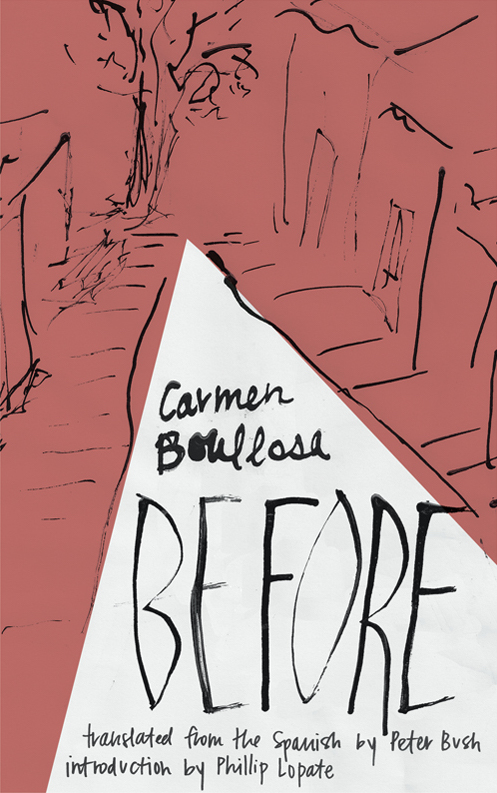Before
by Carmen Boullosa, translated by Peter Bush
reviewed by Alexandra Méndez
Before is the story of a woman trying to give form to herself by recounting her childhood. An early novel by Mexican writer Carmen Boullosa, recently translated by Peter Bush, this slim book reads like a prose poem, by turns blurry and clear, like a dream or a memory.
The narrator, who claims to be dead, tells of her Catholic, upper-middle-class childhood in mid-century Mexico City. Like many Latin American authors, Boullosa is indebted to Juan Rulfo, the Mexican author of Pedro Páramo, a proto-magical realist ghost tale. Boullosa’s narrator holds a “conversation” with the reader that reflects on the narration. Memories become animate as she speaks to them: “Memories, be patient, let me take you one at a time to consider you more favorably, please understand that if you come at the right moment you’ll shine better in my eyes, you’ll burst and liberate all the treasures hiding on the backs of your roan mares.” The memories she narrates are filled with the dread of noises that have no origin and seem to approach the child, seeking her out. Philip Lopate’s insightful introduction to the book helps us see how this extreme version of night terrors may be a sublimation (he calls it a “presentiment”) of more real-world fears.
The narrator describes the sounds that frightened her as a “sonorous lexicon” that “was only a small part of the non-verbal world I invented or inhabited as a child.” The child’s perspective calls attention to the fact that the world we are born into is named by adults, and that this naming falls short. The rest—the unnamed—we must face without the comfort of ready-made words. The distance of memory only heightens the challenge of conjuring and communicating a world.
A deep uneasiness about things that have no form or are difficult to come to terms with permeates the book. The narrator describes seeing, as a child, a strange object that carved a sudden chasm between her and her older sisters, the form and purpose of which she struggled to understand. “I took a closer look: yes, I knew what it was, it was a bra like Esther’s …. But how did you wear them?” This strangely shaped object is the harbinger of changes in the girl’s relationship with her sisters and causes her great consternation. The narrator herself has become something with an uncertain form. Towards the end, she tells us, “I myself have a form within the formlessness, or that’s what I’m trying to affirm through this narrative.” The entire story is a self-reflective attempt at giving shape to the shapeless—and thus to oneself.
The ghost-narrator understands many of the things that happened to her better now than when they were occurring, yet an accurate representation of these events eludes her. She tells the reader of “the drawings … I carved in the dark when I couldn’t sleep, obscene shapes with a solid mass and even breathing … ” She then immediately reflects: “Why did I call them obscene shapes? What did I think obscenity was?” Words are not enough to conjure meaning—they need to be explained with more words, and still the gap remains between object and representation. Boullosa’s rich, detailed prose at once reaffirms the power of poetic language to conjure images and lays bare its limitations—words are never sufficient to ferry meaning seamlessly between subjective human experiences.
The problem is not only one of linguistic representation; it is also one of visual representation. The “obscene shapes” and “drawings” take on a solidity. Shortly after this passage, a wardrobe causes spidery ink blobs on a fancy coat to transform into actual spiders. When the girl attempts to use a drawing and the wardrobe’s special powers to recreate the pebbles she once used to form a ring around her bed to keep out the frightening noises, the wardrobe does indeed produce pebbles, but they are ineffective, and, furthermore, rob her of her ability to dream. The images have real conjuring power, but what they conjure is frightful, and not quite what was intended.
The poetic language and musings do more for this book than the plot. Peter Bush’s translation is an appealing poetic work. Rather than retain the flowing sound of the original, Bush has sought to retain its conversational tone. The challenge of translating a poetic novel is a representational one: How to represent a reading experience to a new audience? Bush’s rendering is poetry of a different kind from Boullosa’s, but poetry nonetheless. Ultimately, Before asks us to interrogate the way we narrate our lives and ourselves and suggests that poetic language is sometimes more apt for this task than crisp, spare description.
Published on August 30, 2017

